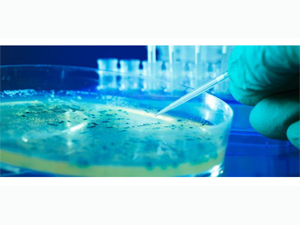



Date:17/08/16
 Scientists are hailing a spectacular breakthrough in cancer research by developing an army of “nanorobots” that can navigate a patient’s bloodstream and target tumours.
Scientists are hailing a spectacular breakthrough in cancer research by developing an army of “nanorobots” that can navigate a patient’s bloodstream and target tumours.
It could help doctors to administer chemotherapy drugs using injections without damaging surrounding organs and healthy tissues.
Researchers at the Polytechnique Montréal, Université de Montréal and McGill University in Canada used the nanorobotic agents – composed of more than 100 million bacteria – to carry out experiments on mice.
They say the dosage of highly toxic cancer drugs could now be significantly reduced. The breakthrough has been published in the journal Nature Nanotechnology.
Professor Sylvain Martel, director of the Polytechnique Montréal Nanorobotics Laboratory, who headed the research team, said: “These legions of nanorobotic agents were actually composed of more than 100 million flagellated bacteria – and therefore self-propelled – and loaded with drugs that moved by taking the most direct path between the drug’s injection point and the area of the body to cure.
”The drug’s propelling force was enough to travel efficiently and enter deep inside the tumours.“
The scientists found that the nanorobots can detect oxygen-depleted tumour areas or hypoxic zones, which are most resistant to most cancer therapies including radiotherapy, and deliver the drugs directly to them.
The bacteria used by Professor Martel’s team move around using a ”compass“ created by a chain of magnetic nanoparticles and have a sensor that measures the oxygen concentration.
By exposing the bacteria to a computer-controlled magnetic field, researchers showed that these bacteria could replicate artificial nanorobots of the future designed for this kind of task.
Professor Martel said: ”This innovative use of nanotransporters will have an impact not only on creating more advanced engineering concepts and original intervention methods, but it also throws the door wide open to the use of new vehicles for therapeutic, imaging and diagnostic agents.
“Chemotherapy, which is so toxic for the entire human body, could make use of these natural nanorobots to move drugs directly to the targeted area, eliminating the harmful side effects while also boosting its therapeutic effectiveness.”
Scientists are using nanorobots to target cancer tumours
 Scientists are hailing a spectacular breakthrough in cancer research by developing an army of “nanorobots” that can navigate a patient’s bloodstream and target tumours.
Scientists are hailing a spectacular breakthrough in cancer research by developing an army of “nanorobots” that can navigate a patient’s bloodstream and target tumours.It could help doctors to administer chemotherapy drugs using injections without damaging surrounding organs and healthy tissues.
Researchers at the Polytechnique Montréal, Université de Montréal and McGill University in Canada used the nanorobotic agents – composed of more than 100 million bacteria – to carry out experiments on mice.
They say the dosage of highly toxic cancer drugs could now be significantly reduced. The breakthrough has been published in the journal Nature Nanotechnology.
Professor Sylvain Martel, director of the Polytechnique Montréal Nanorobotics Laboratory, who headed the research team, said: “These legions of nanorobotic agents were actually composed of more than 100 million flagellated bacteria – and therefore self-propelled – and loaded with drugs that moved by taking the most direct path between the drug’s injection point and the area of the body to cure.
”The drug’s propelling force was enough to travel efficiently and enter deep inside the tumours.“
The scientists found that the nanorobots can detect oxygen-depleted tumour areas or hypoxic zones, which are most resistant to most cancer therapies including radiotherapy, and deliver the drugs directly to them.
The bacteria used by Professor Martel’s team move around using a ”compass“ created by a chain of magnetic nanoparticles and have a sensor that measures the oxygen concentration.
By exposing the bacteria to a computer-controlled magnetic field, researchers showed that these bacteria could replicate artificial nanorobots of the future designed for this kind of task.
Professor Martel said: ”This innovative use of nanotransporters will have an impact not only on creating more advanced engineering concepts and original intervention methods, but it also throws the door wide open to the use of new vehicles for therapeutic, imaging and diagnostic agents.
“Chemotherapy, which is so toxic for the entire human body, could make use of these natural nanorobots to move drugs directly to the targeted area, eliminating the harmful side effects while also boosting its therapeutic effectiveness.”
Views: 440
©ictnews.az. All rights reserved.Similar news
- Azerbaijani project to monitor disease via mobile phones
- Innovative educational system to be improved under presidential decree
- NTRC prolongs license of two TV and radio organizations for 6 years
- Azerbaijan establishes e-registry for medicines
- Azerbaijani museum introduces e-guide
- Nar Mobile opens “Nar Dunyasi” sales and service center in Siyazan city
- International conference on custom electronic services held in Baku
- OIC secretary general to attend COMSTECH meeting in Baku
- Azerbaijan develops earthquake warning system
- New law to regulate transition to digital broadcasting in Azerbaijan
- Azerbaijani State Social Protection Fund introduces electronic digital signature
- Intellectual traffic management system in Baku to be commissioned in December
- Tax Ministry of Azerbaijan started receiving video-addresses
- World Bank recommends Azerbaijan to speed up e-service introduction in real estate
- Azerbaijan to shift to electronic registration of real estate





















